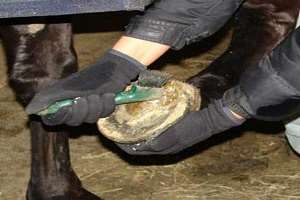By Taylor Fabus
With a damp spring just around the corner, now is an ideal time to consider some common springtime woes for horse owners. Thrush is the destruction of a portion of the horse’s hoof called the frog. This destruction is caused by an anaerobic bacteria and fungi that is not contagious. Thrush often presents itself with a strong smelling odor coming from the affected area.

While somewhat common, thrush should not be taken lightly. If not treated, in some severe cases it may penetrate the sensitive structures of the hoof and form an abscess, or involve other sensitive areas of the hoof.
Treatment
Copper tox and Thrush Buster can work well for treating thrush. Equine podiatrist of Rood and Riddle Veterinary Clinic Scott Morrison identifies and talks about treating thrush in horses in the video, “Identifying and Treating Thrush in Horses.”
Prevention
To prevent thrush, the best offense is a good defense. In other words, prevention and proactive farm management is crucial. The best control for thrush is proper sanitation, especially where your horses will be spending large amounts of their time. Dark and damp conditions are ideal for thrush-causing bacteria to thrive. It would be logical then, if wanting to prevent thrush, to limit these conditions. Check out this Michigan State University Extension article to help manage the mud at your horse farm.
In addition, be sure the horse’s hooves and stall are being cleaned daily with removal of wet spots and manure. If the horse is kept in a run-in shed, the area should be cleaned weekly to help minimize the buildup of organic matter.
Source: msu.edu